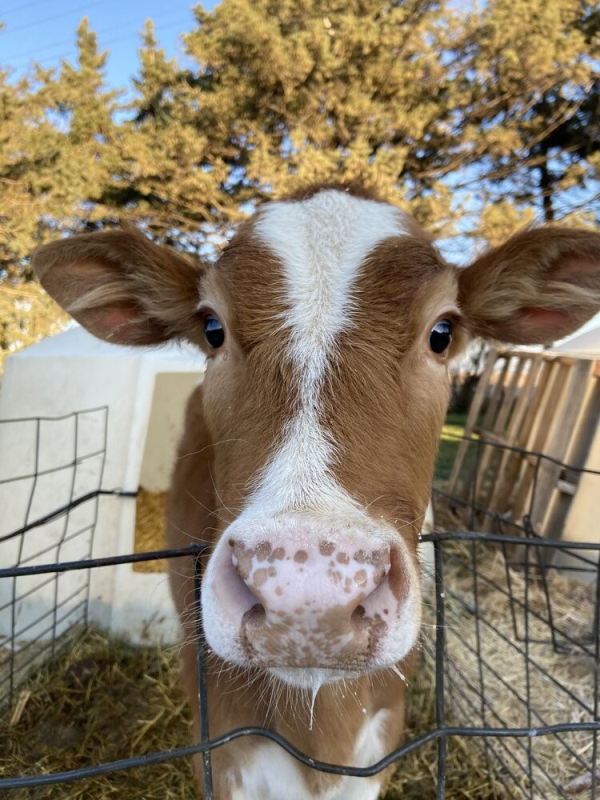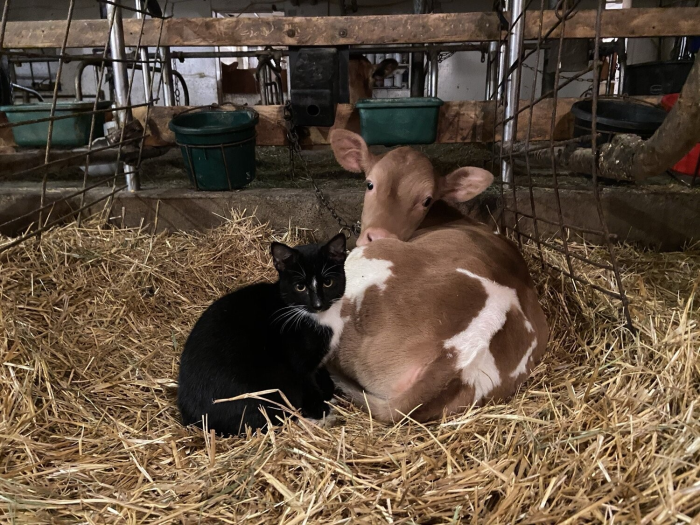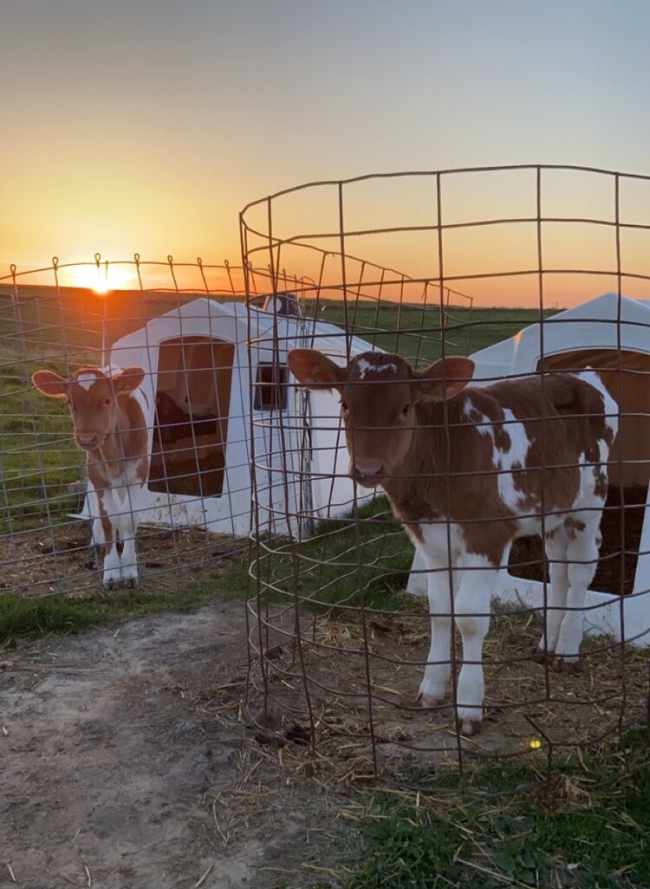Fair Showstoppers Grace the Championship Ring
June 16, 2021
By Ann Thelen
In the months leading up to county fairs and the Iowa State Fair, Prairie Moon Guernseys receive salon-style treatment and special living quarters all before stepping into the show ring. Discover more about this showstopping cattle breed.

It’s not often you hear of cows being pampered with salon-style treatment, but that’s exactly what happens for the Prairie Moon Guernseys leading up to summertime competitions. The big stage for this elite breed of dairy cattle comes in the form of county fairs, the Iowa State Fair and the World Dairy Expo.
The Sivesind family raises the Prairie Moon Guernseys in the northeast Iowa community of Waukon. On this Century Farm, Leslie Sivesind is the fourth generation of the family involved in the operations. Her great-grandfather started the farm, and her grandpa Frank Sivesind is still actively involved along with her dad Dan Sivesind.
Regular fairgoers are sure to recognize the Prairie Moon Guernseys as judges consistently award the family with top honors as championship and premier exhibitors and breeders.
Milk, Cheese and Shows
Showing their championship cows is just one part of the family’s activities on this working farm. The Guernsey breed is known for its high-quality milk, which is high in butterfat (the natural fat contained in milk and dairy products).
Because the Guernseys' milk is naturally high in fat, all the farm's milk goes to creameries, including Wapsie Valley Creamery in Independence, to make delectable cheeses.“We currently milk about 120 cows and have probably 80 to 90 heifer calves. A heifer is a young female cow that has not yet had a calf," explains Leslie, who also works off the farm as a full-time banker. "In addition, we farm about 700 acres of corn, soybeans and alfalfa, most of which is used to feed our cattle."
“In addition to their beautiful coloring and stature, the Guernsey breed is also extremely docile, making it the ideal cattle for shows. Dairy farmers all over the world say the Guernseys’ temperament and disposition make it the easiest breed to work with,” Leslie adds.
Guernsey's range in color from yellow to reddish-brown with white patches and their personalities sparkle. When it comes to getting ready to parade these gorgeous showstoppers at fairs, farm families put in months of work.
“There is a lot of work and expense that go into getting ready for a show, but the time we get to spend as a family getting ready and showing the cows make it all worthwhile,” Leslie explains.

Selecting the Stars of the Fair
The first step in the competition process for the family is picking out the animal to exhibit at shows. The youngest calf that can be taken to a summer show is a March calf or a spring heifer calf. By the time it gets to the show, that calf might only be five months old, depending on when the show is during the summer. With a broad range of show categories, there is also the opportunity to take a one-year-old calf or a two-year-old cow.
“We are very specific when selecting the animals to show each year," Leslie says. "We look at the physical characteristics of each calf. For example, is it big for her age? We don't want to take one that's really small for her age because the chances are somebody else's calf at the fair is going to be a lot bigger.”
In addition, the Sivesinds want the animal to have a long body and deep ribs plus desirable feet and legs. The family is methodical and precise when picking out which calves or cows to exhibit and represent the family farm at the fair.
Once the animals are selected, they are kept separate, and that’s where hours and hours of training, preparations and pampering begin.
“By having the animals in separate pens, we can feed them a specific, higher protein feed ration specifically tailored for a show animal," Leslie explains. "They are also kept in an exceptionally clean and dry pen, where straw and pine shavings are used for bedding.”Once the animals are selected, they are kept separate, and that’s where hours and hours of training, preparations and pampering begin.

A crucial component of getting the animals comfortable with the arenas at shows is halter training. Halter training begins in short increments and slowly increases as the animal becomes accustomed to wearing a halter – not dissimilar to how a dog owner might train a puppy to become used to a collar and leash. It also helps to bond the animal with the individual who will be the exhibitor. Typically, it takes a couple of months to teach the animal to lead on the halter and to walk at the proper pace in the show ring.
Salon-Style Treatment
“Along with halter training, we spend a lot of time washing the animals,” Leslie explains. “Every four days, we wash the show cows with a particular soap. We have specific combs and brushes we use to get them clean and shiny. For example, the special comb we use on their tails could be correlated to what people would use to brush their hair.”

The pampering doesn’t stop there. Hooves are brushed to ensure they shine at showtime. Ears are wiped clean – which the animals love – with a custom cloth. Haircuts – also called clippings – occur at regular intervals several times before it’s time for the fair to help with optimal hair growth.
When the day arrives for the spotlight to be on the Guernseys, more movie star treatment begins.
"We blow-dry the cow’s hair on its top line or back, to make it stand up. Then we use hair spray to keep it in place,” Leslie explains. “It sounds funny, but it adds an inch of height to the animal. They love to be pampered, and we have such a wonderful time preparing the animal for its performance.”
Special leather halters adorn each calf or cow at the show, and the exhibitors also adhere to a strict dress code by always wearing white pants.
Although the Sivesinds are typically the ones showing their cattle, their younger generation has also grown up and is no longer in 4-H.
“We have kids who want to be in 4-H but live in town and don’t have a family farm,” Leslie says. “Each year, we ‘lease’ a couple of our calves, so the kids can get the experience without owning the animals. We also recently participated in Discover Dairy’s Adopt-a-Cow year-long virtual program, where students adopted a cow and kept track of her the entire year. Buttercup was our star calf for the past year, and it was so much fun to be a host farm and watch the students' engagement."

Lifelong Impacts
Showing Guernseys is a family affair and creates lifelong lessons and bonds.
“It's an excellent opportunity for you to showcase your animals and for others to see the quality of animals that you have, as well as it's just gratifying and prideful for us,” Leslie explains.
"It's a good opportunity for my family and me to spend time with each other. My dad and brothers are passionate about showing cattle and the dairy industry, just like I am.
“Sometimes we spend the most time together at a show while we're getting ready. It's a lot of hard work and dedication, but we are passionate about it and enjoy it. It's a good family thing for us to do together, and I think most people who show livestock would probably say the same thing.”
Celebrate June Dairy Month and involve the kids by making this cheesy, marvelous recipe at home. Recipe courtesy of Midwest Dairy.
MARVELICIOUS MAC AND CHEESE
INGREDIENTS
2½ cups fat-free milk
2 cups elbow macaroni uncooked, 7 ounces
1 tablespoon butter
3 tablespoons all-purpose flour
¾ teaspoon salt
½ teaspoon dry mustard
2½ cups shredded reduced-fat sharp cheddar cheese reserve ½ cup for topping
INSTRUCTIONS
Preheat oven to 375 degrees F. Cook macaroni according to package directions.
Meanwhile, heat milk and butter in a medium saucepan over medium heat. Gradually whisk in flour, salt and dry mustard and simmer for 1 minute, whisking occasionally.
Remove from heat; stir in 2 cups of cheese until melted. Add drained macaroni to saucepan and toss with cheese sauce. Transfer mixture to an 8- or 9-inch square baking dish; top with ½ cup shredded cheese.
Bake uncovered until hot and bubbly, about 20 minutes. Let stand 5 minutes before serving.